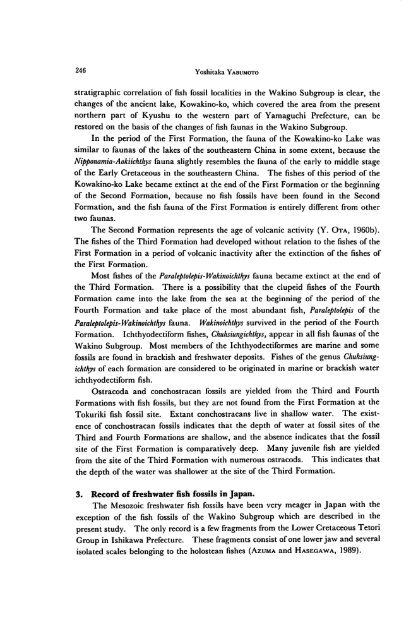Early Cretaceous Freshwater Fish Fauna in Kyushu, Japan
Early Cretaceous Freshwater Fish Fauna in Kyushu, Japan
Early Cretaceous Freshwater Fish Fauna in Kyushu, Japan
Create successful ePaper yourself
Turn your PDF publications into a flip-book with our unique Google optimized e-Paper software.
246 Yoshitaka Yabumoto<br />
stratigraphic correlation of fish fossil localities <strong>in</strong> the Wak<strong>in</strong>o Subgroup is clear, the<br />
changes of the ancient lake, Kowak<strong>in</strong>o-ko, which covered the area from the present<br />
northern part of <strong>Kyushu</strong> to the western part of Yamaguchi Prefecture, can be<br />
restored on the basis of the changes of fish faunas <strong>in</strong> the Wak<strong>in</strong>o Subgroup.<br />
In the period of the First Formation, the fauna of the Kowak<strong>in</strong>o-ko Lake was<br />
similar to faunas of the lakes of the southeastern Ch<strong>in</strong>a <strong>in</strong> some extent, because the<br />
Nipponamia-Aokiichthys fauna slightly resembles the fauna of the early to middle stage<br />
of the <strong>Early</strong> <strong>Cretaceous</strong> <strong>in</strong> the southeastern Ch<strong>in</strong>a. The fishes of this period of the<br />
Kowak<strong>in</strong>o-ko Lake became ext<strong>in</strong>ct at the end of the First Formation or the beg<strong>in</strong>n<strong>in</strong>g<br />
of the Second Formation, because no fish fossils have been found <strong>in</strong> the Second<br />
Formation, and the fish fauna of the First Formation is entirely different from other<br />
two faunas.<br />
The Second Formation represents the age of volcanic activity (Y. Ota, 1960b).<br />
The fishes of the Third Formation had developed without relation to the fishes of the<br />
First Formation <strong>in</strong> a period of volcanic <strong>in</strong>activity after the ext<strong>in</strong>ction of the fishes of<br />
the First Formation.<br />
Most fishes of the Paraleptolepis-Wak<strong>in</strong>oichthys fauna became ext<strong>in</strong>ct at the end of<br />
the Third Formation. There is a possibility that the clupeid fishes of the Fourth<br />
Formation came <strong>in</strong>to the lake from the sea at the beg<strong>in</strong>n<strong>in</strong>g of the period of the<br />
Fourth Formation and take place of the most abundant fish, Paraleptolepis of the<br />
Paraleptolepis-Wak<strong>in</strong>oichthys fauna. Wak<strong>in</strong>oichthys survived <strong>in</strong> the period of the Fourth<br />
Formation. Ichthyodectiform fishes, Chuhsiungichthys, appear <strong>in</strong> all fish faunas of the<br />
Wak<strong>in</strong>o Subgroup. Most members of the Ichthyodectiformes are mar<strong>in</strong>e and some<br />
fossils are found <strong>in</strong> brackish and freshwater deposits. <strong>Fish</strong>es of the genus Chuhsiung<br />
ichthys of each formation are considered to be orig<strong>in</strong>ated <strong>in</strong> mar<strong>in</strong>e or brackish water<br />
ichthyodectiform fish.<br />
Ostracoda and conchostracan fossils are yielded from the Third and Fourth<br />
Formations with fish fossils, but they are not found from the First Formation at the<br />
Tokuriki fish fossil site. Extant conchostracans live <strong>in</strong> shallow water. The exist<br />
ence of conchostracan fossils <strong>in</strong>dicates that the depth of water at fossil sites of the<br />
Third and Fourth Formations are shallow, and the absence <strong>in</strong>dicates that the fossil<br />
site of the First Formation is comparatively deep. Many juvenile fish are yielded<br />
from the site of the Third Formation with numerous ostracods. This <strong>in</strong>dicates that<br />
the depth of the water was shallower at the site of the Third Formation.<br />
3. Record of freshwater fish fossils <strong>in</strong> <strong>Japan</strong>.<br />
The Mesozoic freshwater fish fossils have been very meager <strong>in</strong> <strong>Japan</strong> with the<br />
exception of the fish fossils of the Wak<strong>in</strong>o Subgroup which are described <strong>in</strong> the<br />
present study. The only record isa few fragments from the Lower <strong>Cretaceous</strong> Tetori<br />
Group <strong>in</strong> Ishikawa Prefecture. These fragments consist ofone lower jaw and several<br />
isolated scales belong<strong>in</strong>g to the holostean fishes (Azuma and Hasegawa, 1989).

















